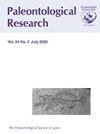The Structure of the Miocene Northwestern Pacific Ichthyofauna as Revealed By Two Fossil Fish Assemblages From Sakhalin Island, Russia
IF 0.6
4区 地球科学
Q3 PALEONTOLOGY
引用次数: 0
Abstract
Abstract. Two coeval assemblages of fossil fishes came from the middle–late Miocene deposits of Sakhalin Island, Russia. The fish community from the Agnevo Formation consists of 28 species belonging to 15 families of shallow-water fishes, with the predominance of cottoids, stichaeoids, and pleuronectoids. The assemblage from the Kurasi Formation contains fossils of 35 species from 27 fish families and comprises mainly mesopelagic dwellers, such as myctophids, argentiniforms, stomiiforms, and aulopiforms. These assemblages differ mainly in the number of species belonging to extinct genera. Among the 28 fish genera known from the Agnevo Formation, 14 (50%) genera are extinct. In contrast, out of 35 genera described from the Kurasi Formation only three (about 8.6%) genera are extinct. The morphological distances between the fossil and recent congeneric species are more pronounced and defined in the shallow-water community than in the deep-water assemblage. The differences in taxonomic composition between the fossil assemblages likely reflect the different influence of the climatic and geographic events in the Neogene and Quarternary on the evolutionary rates of shallow- and deep-water fish communities.俄罗斯库页岛两个鱼类化石组合揭示的中新世西北太平洋鱼类的结构
摘要来自俄罗斯库页岛中新世中晚期沉积物的两组同一时期的鱼类化石。Agnevo组鱼类群落由浅水鱼类15科28种组成,以尾形、尾形和胸膜形鱼类为主。库拉西组的组合包含27个鱼类科的35种化石,主要包括中远洋居民,如嗜菌鱼、阿根廷鱼、口形鱼和拟形鱼。这些组合的区别主要在于属于灭绝属的物种数量。在Agnevo组已知的28种鱼类中,有14种(50%)已经灭绝。相比之下,在Kurasi组描述的35个属中,只有3个(约8.6%)属已经灭绝。在浅水群落中,化石与最近的同类物种之间的形态距离比在深水群落中更为明显和明确。化石组合在分类组成上的差异可能反映了新近纪和第四纪气候和地理事件对浅水和深水鱼类群落进化速率的不同影响。
本文章由计算机程序翻译,如有差异,请以英文原文为准。
求助全文
约1分钟内获得全文
求助全文
来源期刊

Paleontological Research
PALEONTOLOGY-
CiteScore
1.60
自引率
0.00%
发文量
47
审稿时长
>12 weeks
期刊介绍:
Paleonotological Research (PR) is a quarterly, peer-reviewed international journal, which focuses on original contributions primarily in the area of paleontology but also covering a wide range of allied sciences. It has been published since 1997 as a successor to the former journal Transactions and Proceedings of the Palaeontological Society of Japan. The emphasis of contributions will include global and local perspectives, and contents can cover all ages (Precambrian to the Quaternary, including the present time).
 求助内容:
求助内容: 应助结果提醒方式:
应助结果提醒方式:


